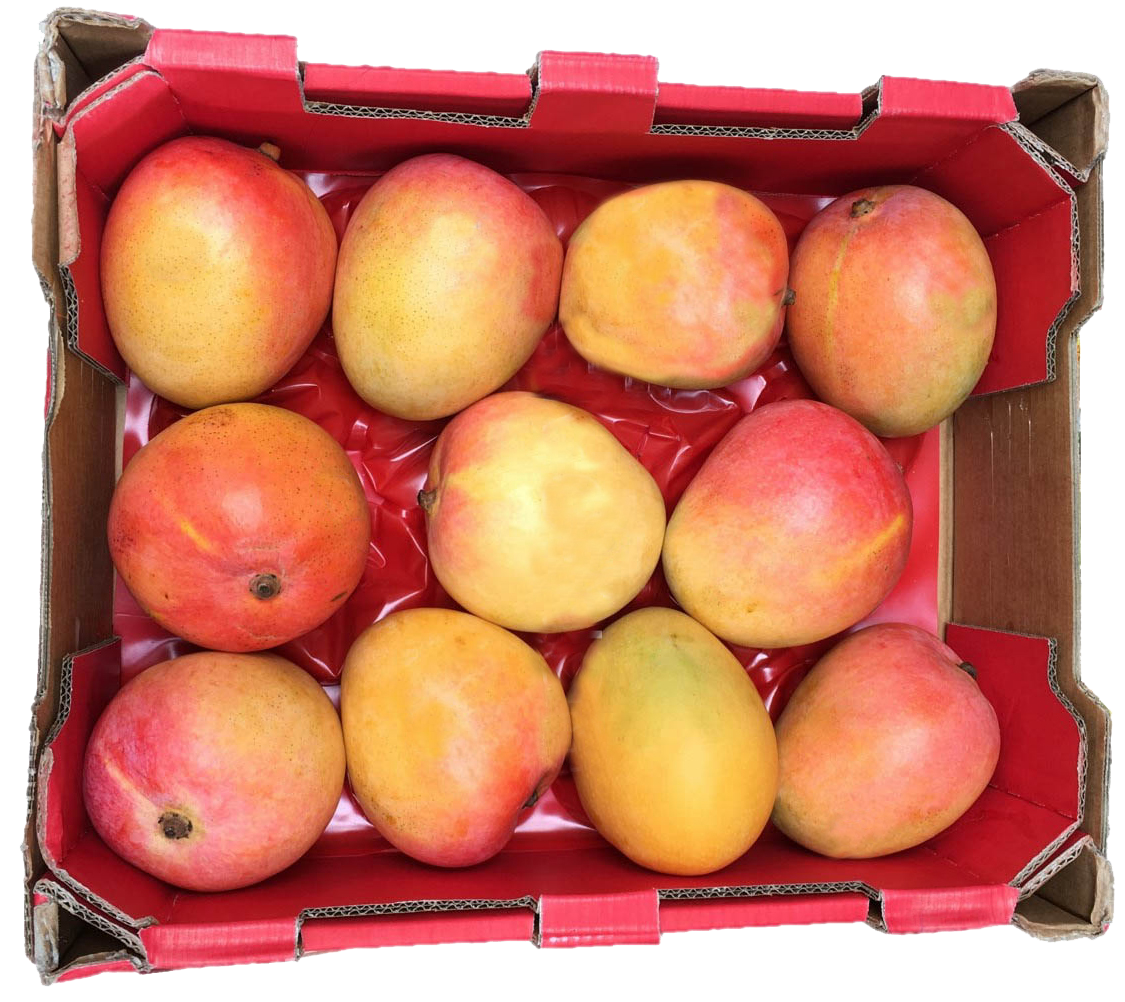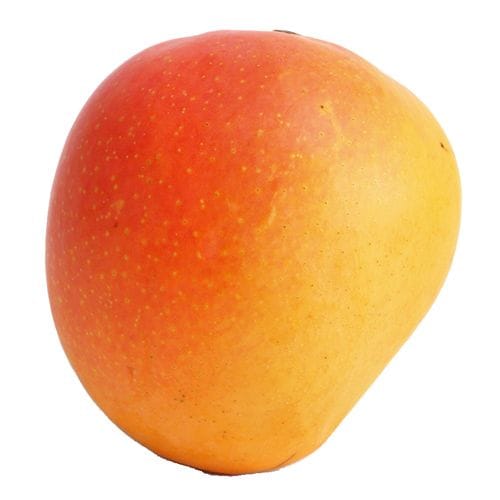"This fruit has a sweet mild flavour."
-Department of Agriculture and Fisheries

Mango hybrid R2E2
R2E2 is a mid-season variety with large, highly coloured fruit. It was selected in 1982 by Ian Bally, Ross Wright and Peter Beal as a seedling progeny of the Florida variety Kent, and takes its name from the row and position in the field of the original tree at the department´s Bowen Research Facility.
Released for commercial production in 1991, R2E2 has gained wide acceptance throughout all mango-growing regions in Australia and is the third most popular variety grown. R2E2 has a long shelf life and is sought after on the export market.
Fruit characteristics
| Fruit shape | round ovate* |
| Fruit weight | 600 g-1 kg |
| Average fruit length | 107 mm |
| Average fruit width | 77 mm |
| Average fruit depth | 107 mm |
| Fruit ground colour | Green-yellow |
| Fruit blush | Orange red |
| Lenticels | Small and yellow |
| Pulp colour | Lemon yellow |
| Pulp fibre | Low |
| Pulp firmness | Firm |
| Pulp recovery | 77% |
| Fruit Flavour | sweet mild flavour |

Tree characteristics
R2E2 is a medium-to-highly vigorous tree with an upright, open canopy. Branches are brittle and easily snap. The tree grows extremely fast in the first few years after planting. Tree vigour slows considerably when the tree reaches the mature bearing stage at 4-5 years and is regularly bearing fruit. Six-year-old trees can reach 6 m and higher, and have a canopy diameter of 5 m.
Flower characteristics
- panicle* length - 10-20 cm
- panicle width - 5-10 cm
- hair density - none to few
- colour - dull red
- wilted petals - red-pink
Propagation
R2E2 is a polyembryonic* variety. However, it is known to produce a small percentage of monoembryonic* seeds that, if planted, will not bear fruit true to type. For this reason, R2E2 should be propagated as grafted trees. Grafted trees have a shorter juvenile phase, settling into regular production earlier and reducing the early vigour of the tree.
Plant density
Although R2E2 is a large and vigorous tree, spacing can be closer than those used for Kensington Pride because of its upright growth habit. A recommended spacing is 4-6 m in the row and 9 m between rows (184 trees/ha). However, some recent plantings are much more dense at 4 x 7 m (357 trees/ha).
Pruning and shaping
R2E2 is extremely vigorous in the first few years after planting and, if left unpruned, will develop long, upright branches with few fruiting terminals. In the first two years, the tree will need pruning 2-3 times a year to develop a well-branched frame capable of holding heavy crops in later years. The limbs should be pruned every second growth flush, forcing them to branch.
Because of R2E2's upright growth habit, pruning to reduce height is essential in the early years. When the tree begins to bear regularly at 5-6 years, the vegetative vigour slows and annual pruning is adequate.
Harvesting considerations
R2E2 is a mid-to-late season variety maturing 2-4 weeks after Kensington Pride. The fruit is firm when ripe and has an extended shelf life. For best flavour and appearance, the fruit should be harvested when the nose of the fruit shows signs of yellowing. Fruit picked at this stage is still firm enough to be handled by sorting and packing equipment and arrives on the market at the optimal eating stage. Because of R2E2's large fruit size, high-sided mango trays (130 mm) are needed for marketing to prevent the fruit bruising.
Pest and disease status
R2E2 is similar to Kensington Pride in its tolerance to anthracnose (Colletorichum gleosporiodies) but it is slightly more susceptible to bacterial black spot (Xanthomonas campestris pv. mangiferaeindicae) than Kensington Pride, though less susceptible than Keitt. R2E2 is affected by major insect pests such as mango scale (Aulacaspis tubercularis), Tipborer (Penicillaria jocosatrix and Chlumetia euthysticha), fruit flies (Bactrocera sp.) and planthopper (Colgaroides acuminata).
Fruit disorders
R2E2 is generally not affected by many disorders. However, some internal fruit breakdown has been reported in trees growing on sandy soils. The sap of R2E2 will cause sapburn, though damage is not as severe as with Kensington Pride. Skin browning is often seen on ripe fruit.
R2E2 is the most susceptible of the Australian varieties to boron deficiency. In boron-deficient trees, the flowers may be kinked or bent in the main stem, and leaves are bent with ragged edges and small holes. In severe cases, cracks appear in the trunk and major limbs that ooze black gummy sap. Trees growing on sandy soils, similar to the granitic sands of the Mareeba district, are the most prone to boron deficiency.
Marketing
R2E2 fruit is highly sought after and generally fetches higher prices on the domestic markets than other varieties. R2E2's colour, shelf life and overall quality make it well suited to export markets. R2E2 has export clearance for Japan after treatment with approved vapour heat treatment for fruit fly disinfestation.

